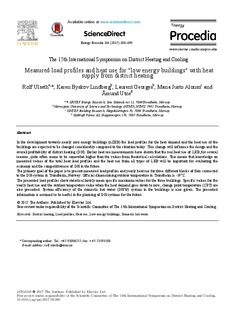Measured load profiles and heat use for “low energy buildings” with heat supply from district heating
Journal article, Peer reviewed
Published version
Permanent lenke
http://hdl.handle.net/11250/2451340Utgivelsesdato
2017Metadata
Vis full innførselSamlinger
- Publikasjoner fra CRIStin - SINTEF AS [5802]
- Publikasjoner fra CRIStin - SINTEF Energi [1640]
- SINTEF Community [2248]
- SINTEF Energi [1764]
Sammendrag
In the development towards nearly zero energy buildings (nZEB) the load profiles for the heat demand and the heat use of the buildings are expected to be changed considerably compared to the situation today. This change will influence the design and the overall profitability of district heating (DH). Earlier heat use measurements have shown that the real heat use of LEB, for several reasons, quite often seems to be somewhat higher than the values from theoretical calculations. This means that knowledge on measured values of the total heat load profiles and the heat use from all types of LEB will be important for evaluating the economy and the competitiveness of DH in the future. The primary goal of the paper is to present measured load profiles and yearly heat use for three different blocks of flats connected to the DH-system in Trondheim, Norway. Official dimensioning outdoor temperature in Trondheim is −19°C. The presented load profiles show statistical hourly mean specific maximum values for the three buildings. Specific values for the yearly heat use and the outdoor temperature value when the heat demand goes down to zero, change point temperature (CPT) are also presented. System efficiency of the domestic hot water (DHW) system in the buildings is also given. The presented information is assumed to be useful in the planning of DH-systems for the future.
